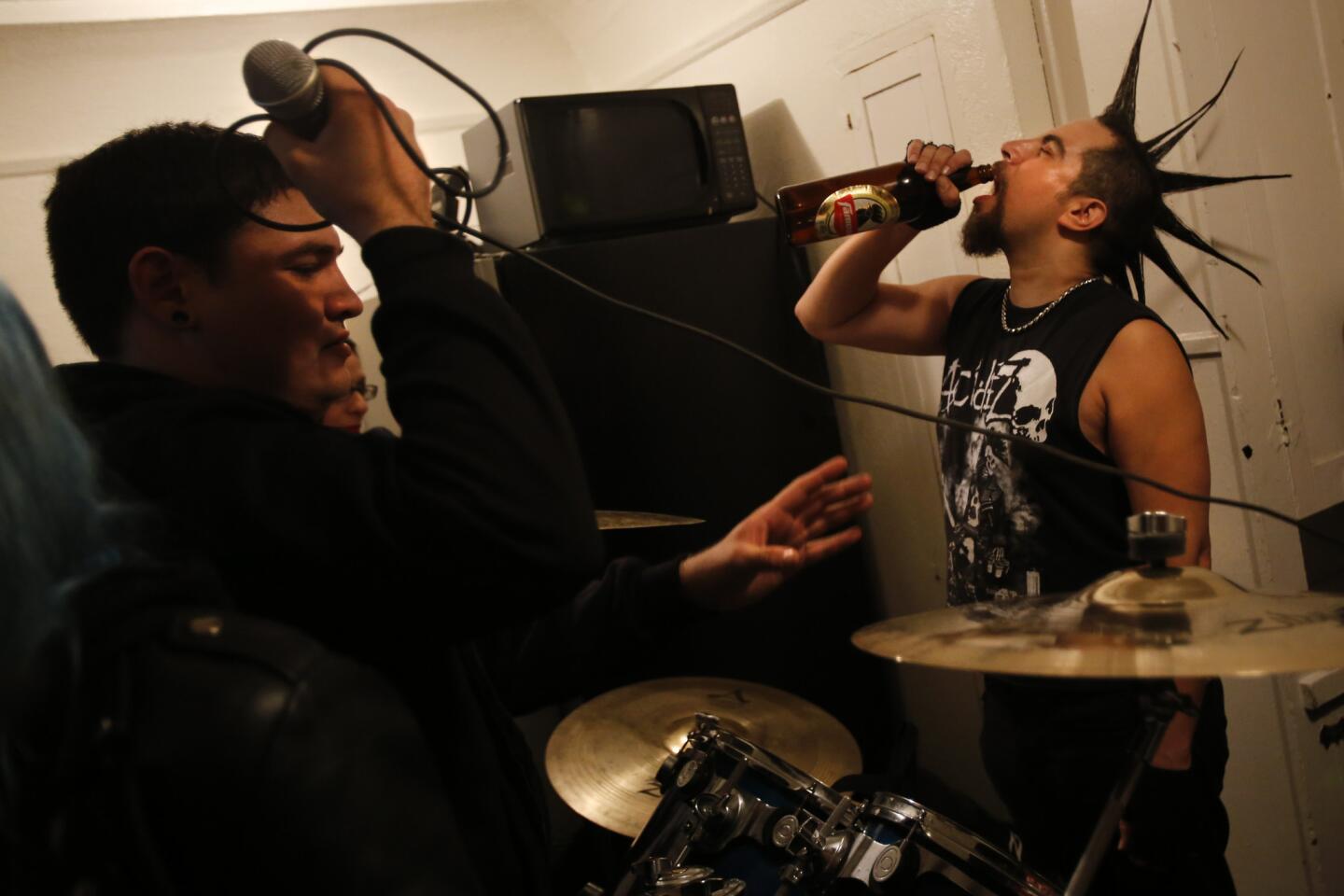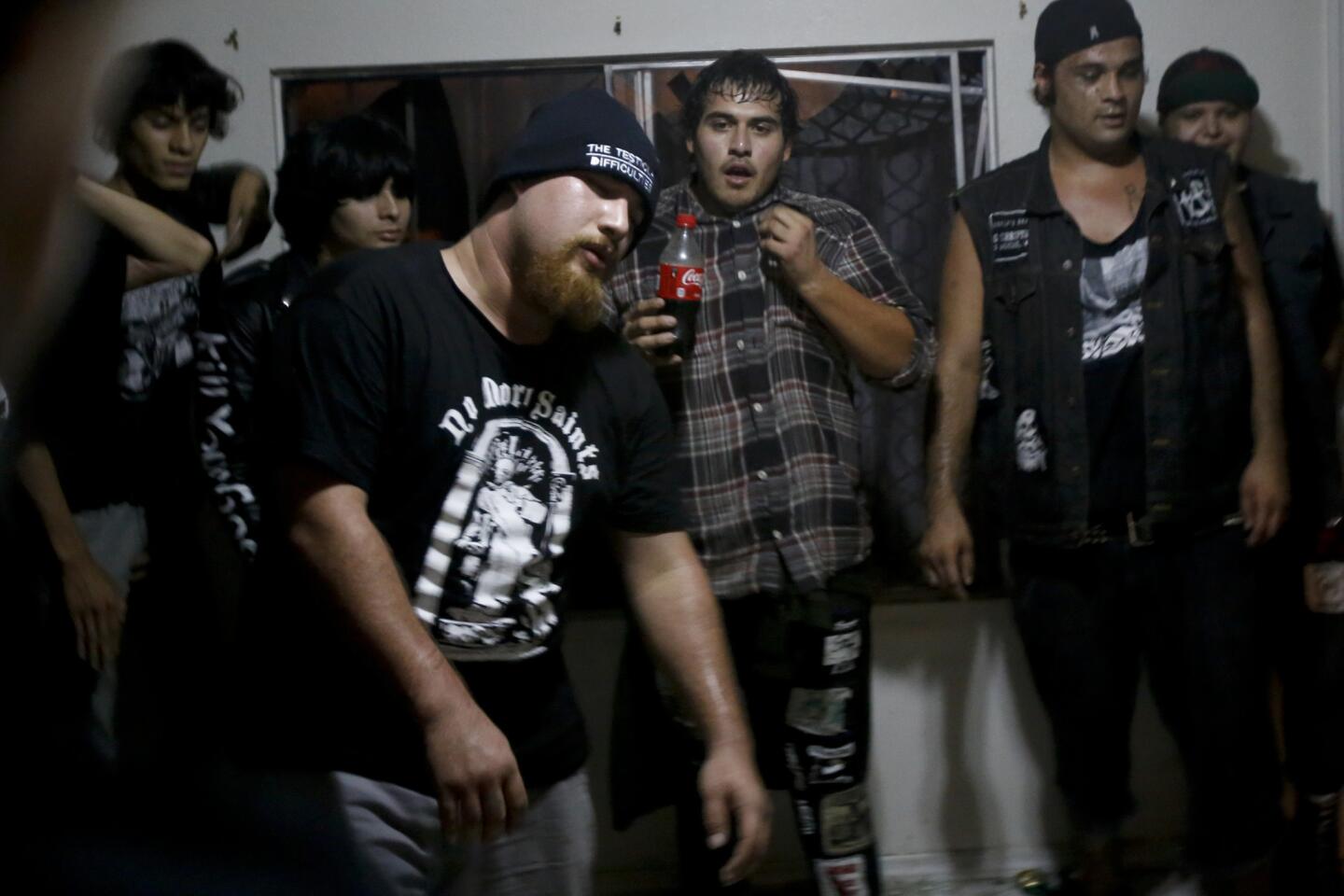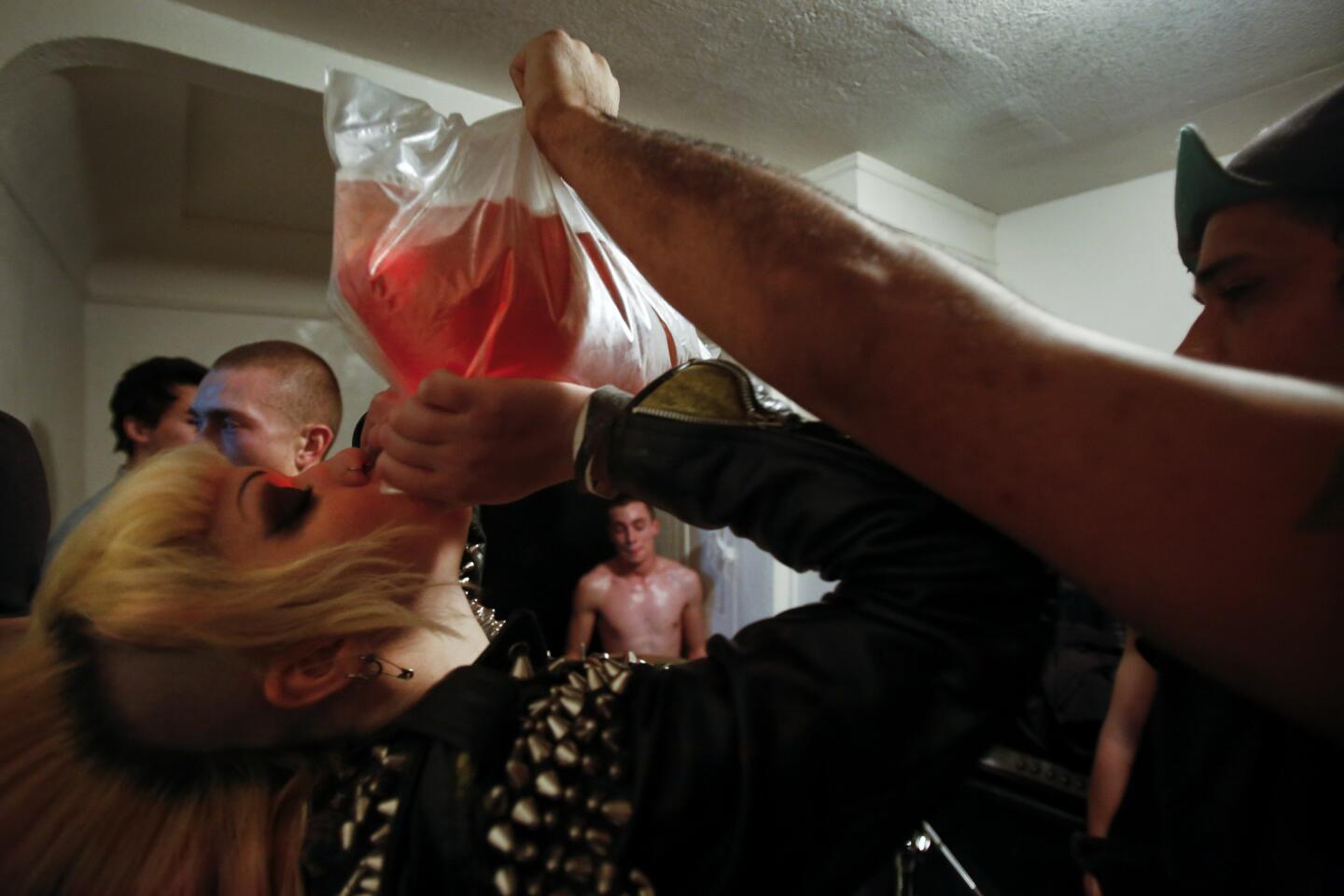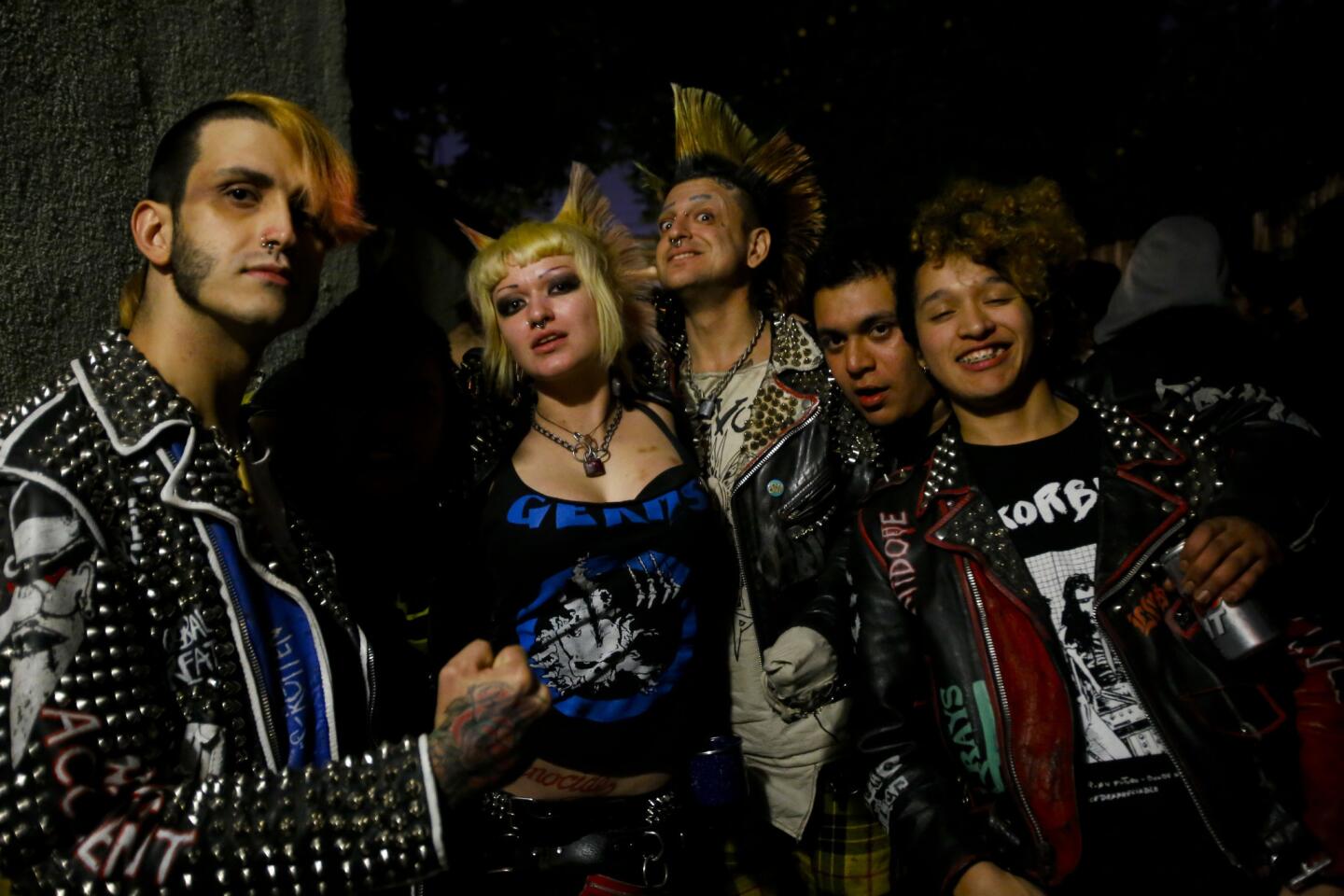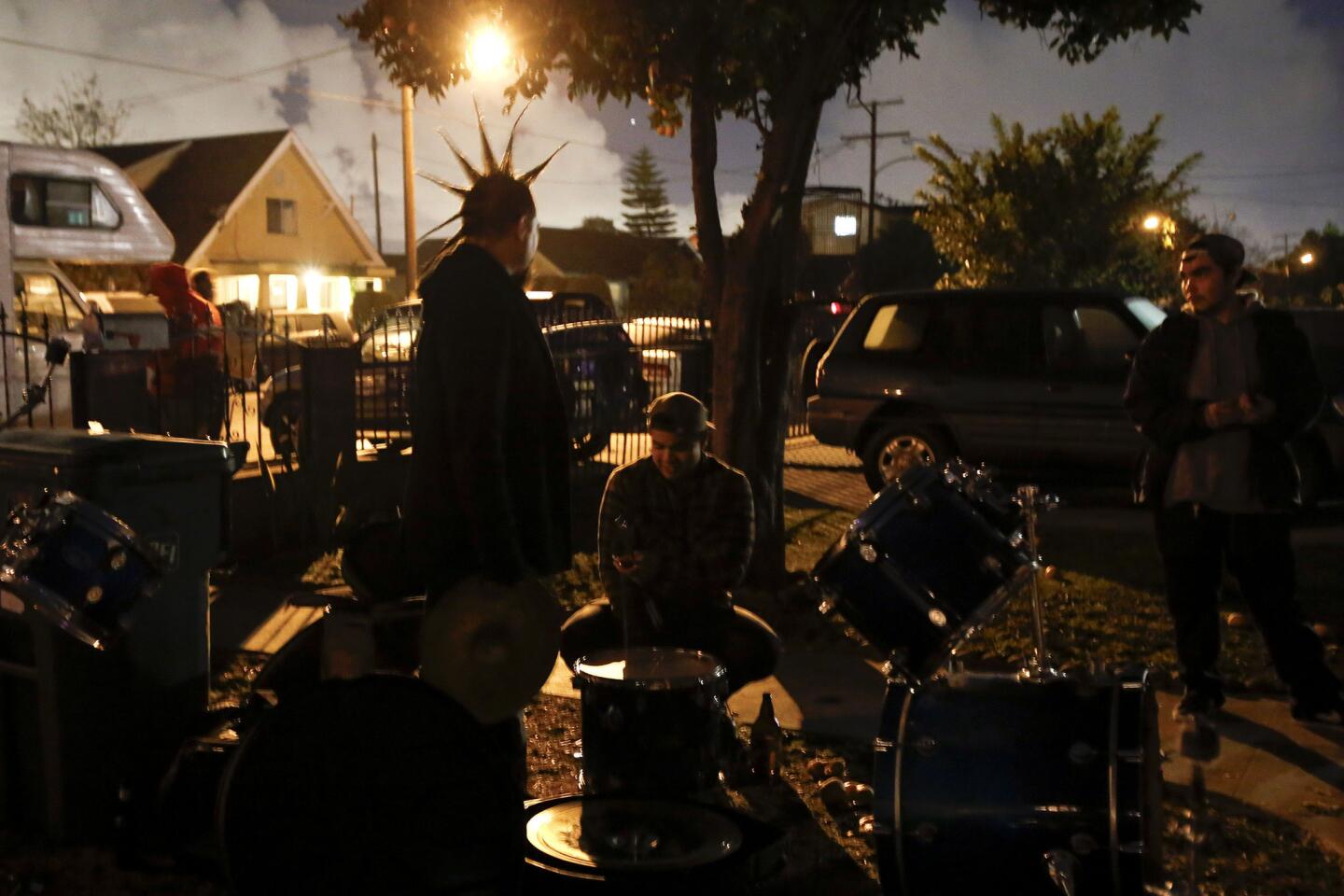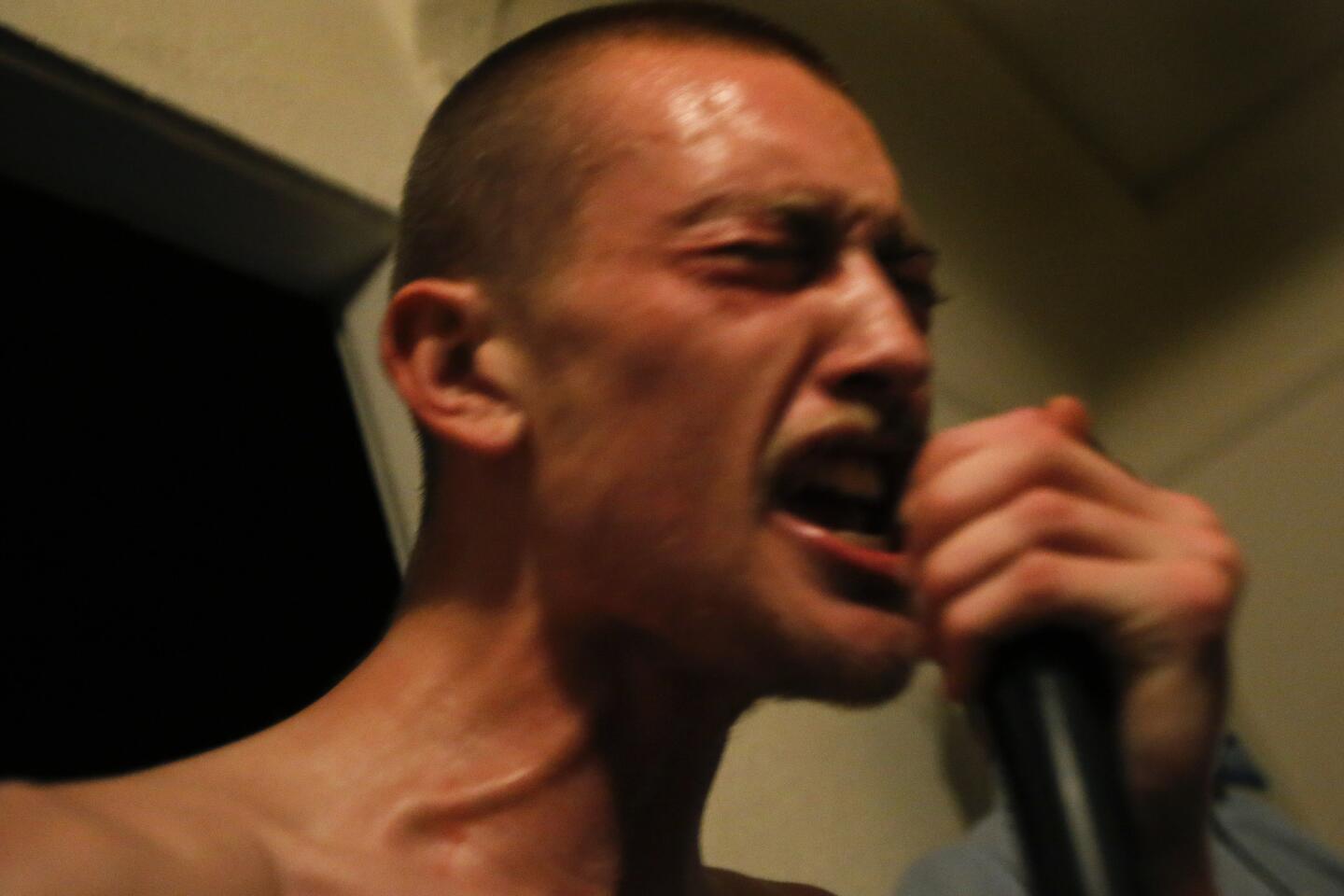Great Read: It’s a mosh-up at South L.A.’s underground punk rock shows
- Share via
They arrive at the South Los Angeles home carrying cases of beer, weed pipes and liquor bottles stashed in brown paper bags — enough, they hope, to carry them through the night.
“No in-and-outs. If you go in, you stay in,” says the woman collecting the $6 cover.
The place looks empty as the new arrivals cross the frontyard. They walk up to a blanket strung between a barred window and a chain-link fence in the side yard and pull it aside.
Punk rockers are everywhere, with blue, pink and red hair spiked up in 5-inch-high mohawks, piercings and studded everything.
They’re here for a show.
It’s all part of an underground punk rock scene that for decades has drawn Latinos to backyard shows far from the clubs of the Westside or Hollywood. In the heaving mosh pit, they find an escape — from family, money problems and society’s judgment.
When a singer starts screaming into the microphone, people in the pit room inside begin shoving one another. Some slip on spilled beer and connect hard with the alcohol-slick tile floor, despite the small red blanket placed there to prevent falls. Others — one wearing a “Beer: Now cheaper than gas” shirt — press against the wall trying to remain out of the chaos.
The packed bodies push so hard they shatter a window, sending glass flying into the dirt and grass of the frontyard. A few hours later, another window goes.
The rooms vibrate with the music and the crowd head-bangs to it, losing themselves in the sound and confusion. The red blanket gets tossed like a rag doll out of the middle of the room.
“You ... animals! You just threw the blanket!” a woman shouts. “The mosh blanket is ruined!”
::
There are rules.
No putting your arm around someone’s neck, no throwing someone down and no trying to start a fight. The first time Tony Gonzales stepped into the pit, he remembers flailing his arms so hard, one fist came back with a tooth in it.
“The first time you ever go into the pit, you’ll know if you like the scene or not,” says Gonzales, a La Puente resident who went to his first show eight years ago, when he was 14. “And after you get hit in the face for the first time, you kind of just get into it.”
Growing up in an abusive family, he said he got into a lot of fights — until he found punk.
“If it wasn’t for that, I probably would be in a bad place right now,” Gonzales says. “It’s kind of like a family. When you go to a show, you’re taken care of.”
When Willie Herron III started his band, Los Illegals, more than 30 years ago, the scene helped him express his feelings about growing up around gang violence in the housing projects. He feels the same way today.
“I’d rather see the youth go into the punk rock genre to express themselves and to unload their frustrations, anger and angst than to join a gang and be some social menace,” Herron says.
Herron, 62, helped open The Vex nightclub in 1980, with the goal of getting East L.A. bands exposure they weren’t getting on the Westside club circuit at the time.
“Pretty much the way we all exposed ourselves in East L.A. was playing backyard parties,” Herron says. “We weren’t able to get into the club circuit. We didn’t have that kind of representation.”
Although club owners are more open-minded now, the backyard parties survive, says Ignacio Rodriguera, the organizer of the South L.A.show.
On this Friday night, Rodriguera — known as Nacho — has pulled in Battalion of Saints, a San Diego hard-core punk band, as well as local bands and bands from around the U.S. The forecast called for rain, so the bands are playing inside instead of the backyard.
When he isn’t performing with his band, Corrupted Youth, or organizing shows, Nacho works as an assistant chef in a hospital. Like many other punk rockers, he juggles work and the punk rock scene.
“Some people look at us like we’re scum, dirtbags, lowlifes and bums,” Nacho says. “But we’re all working-class.”
Angela Boatwright is working on a documentary — funded by Vans — that examines the punk scene in East and South L.A.
Over the past couple of years, Boatwright has spent a lot of time with punk rockers.
“These are just human beings doing whatever they can to enrich their lives,” Boatwright says. “I think people nationally and internationally see Los Angeles as Hollywood … these kids live here too. This is their home, their Los Angeles, their city. They have a voice and they deserve to be heard.”
::
Inside the house, band members crowd drums, guitars and microphone stands into one of the small rooms. Partygoers are packed together in the kitchen, where musicians go through their sound check.
In the pit room next door, 30 people greet one another easily, offering their stashes to anyone who came empty-handed or has run out. A stumbling girl with yellow-and-pink spiked hair chugs from a clear plastic bag of wine being passed around.
Although Latinos make up the majority of the crowd, there’s a mix of ethnicities. But when people come to a show, appearances fade away.
“Every time we’re in the streets, people make us feel [bad] because of how we look and how different we are,” says Gabriel Herrera, 21. “But here we’re all the same. We all believe in the same thing and we feel at home.”
Anthony Macias, 25, got into the scene when he was 14 or 15. Growing up in Boyle Heights, he was raised by his grandparents because his mother worked constantly and he didn’t see his father much.
Sometimes financial and family problems snowball and people end up looking for a way out, he says.
“You have a bad day and get stressed out and punch someone in the street, you’re going to go to jail,” he says. “But if you have a bad day and come to a show, you can blow off some steam and people are probably going to shake your hand.”
::
Sheriff’s deputies come to the show 20 minutes in; neighbors have complained about the noise. Worried that officers might shut it down, Nacho tries to move the crowd hanging out in the frontyard.
“Everyone please move it to the back, por favor,” Nacho calls out. He is already prepared with an alternative venue on 83rd Street. But the deputies are merciful that night, warning them to keep it down before driving off.
But soon, the first window is broken — prompting another warning from deputies.
The woman who lives in the house demands to know who’s paying for the damage. She’s moving out the next day and rented out the house for the show for $150. (Her security deposit seems in jeopardy.)
Behind the blanket in the side yard, a 21-year-old fills up green and blue balloons with nitrous oxide from a red pressurized tank, handing them out like party favors to anyone interested in shelling out a few dollars.
Everyone has a cigarette, beer or balloon in hand, joking with one another in the chilly night air — a sharp contrast to the stifling heat inside.
Even when the music stops around 1 a.m. and the final band packs up its equipment, some of the crowd remains outside amid the beer cans and cigarette butts.
“Nobody go home, we might have another location,” one girl says, stumbling and leaning against a wall for support.
“Party rock!” another man howls.
Anthony Macias surveys the broken windows and trash littering the yard. Blood covers part of his shirt, but he has no idea whose it is. To an outsider, it seems like a pretty crazy party.
Macias shrugs.
“This is nothing.”
Twitter: @brittny_mejia
More to Read
Sign up for Essential California
The most important California stories and recommendations in your inbox every morning.
You may occasionally receive promotional content from the Los Angeles Times.


